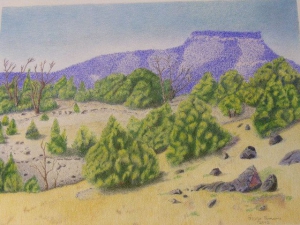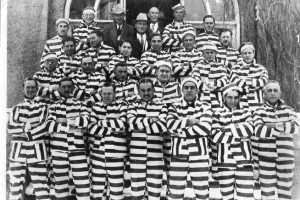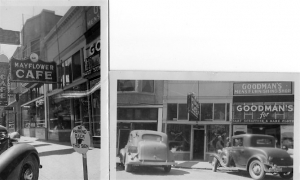George Pomonis
Born in Santa Fe in the early 1930's. Second child of three born to Tom Pomonis and Helen (Vorres) Pomonis. Parents immigrants from Greece. I am a graduate of the Santa Fe Public School System having attended Wood-Gormely, Harrington Jr. Hi and graduating from SF High School in 1950. I am a retired organic chemist. I was employed by the Denver Research Institute (1957-58), Lasdon Foundation Research Institute for Chemotherapy as a research chemist (1958-63), Geigy Pharmaceutical Co. as research chemist (1963-65), and Bioscience Research Laboratory ARS/USDA as a senior scientist 1965-97.) I served in the US Army 1956-57. I spent a 1 year sabbatical in Athens, Greece at the Demokritos Research Institute.
On and Around the Plaza in the 1930's - 1940's (continued.)
On and Around the Plaza in the 1930’s and 40’s
(continued)
George Pomonis
This last summer (August of 2012) we brought one of our daughters and her family to the Native American Market in Santa Fe and to see where grandpa grew up. Taking the tour of the event around and on the Plaza I was struck by the number of boutique stores, fine art shops hotels and finery shops in the area. At least one of the old restaurants, two museums and the La Fonda Hotel still remained. A much different place than it was when I lived and worked there.
The Plaza was, as it had been in the centuries before, the center of commerce for the city and the region. Most people had to come “down town” to the Plaza to conduct business on at least a weekly basis. There were two Five and Dime Stores, shoe stores, haberdashers, women’s wear, shoe stores, three movie theaters, hardware stores, a lumber yard, three grocery stores three jewelers, two banks, a catalog store and eventually a Sears store. Many of the fraternal organizations had their meeting halls downtown. There were two pharmacies, two telegraph companies, a candy kitchen, several curio stores, barbershops, and department stores. There was a pool hall on the south side of the Plaza which eventually moved to Galesto St. and another two doors west of the Lensic Theater. There was the luxury La Fonda Hotel, the De Vargas, El Fidel, Montezuma and Plaza hotels all within two blocks of the Plaza. The public high school was also two blocks north of the Plaza.
A great change began to occur after WW II and especially in the late 1950’s into the 1960’s when it was realized that Santa Fe because of its history, culture, idyllic location and four seasons of climate was a perfect place to attract tourists and growth. The returning veterans were full of ambition and ideas for sparking changes and taking advantage of this idyllic place, and so growth appeared. Commerce began to expand to the south on Cerrillos road and an east-west bypass named Coronado road. The forming of St. Michaels College from the old Bruns Military Hospital on Cerrillos Road also spurred growth in the post war years. By the middle of the 1950’s I had permanently left my hometown of Santa Fe and therefore was not privy as to the day–to-day and year to year changes that began to appear.
My recollection of those years are those of a child and a teenager; but because my father had a restaurant (Mayflower Cafe) on the south side of the Plaza and because I worked in the restaurant from the time I was twelve years of age I became familiar with the merchants and businesses that were on and around the Plaza. The merchants patronized each other.
Many of the restaurants on and around the Plaza of those years were owned or operated by Greeks. The Burro Alley Café (across from the Lensic Theater) was owned by John Komis. The Faith Café (now Evangelos) was owned by Alex and Euterpe Kalangis. On the south side of the Plaza was the Mayflower Café owned by Tom and Pete Pomonis and the Capital City Café owned by John Ligits. Around 1938 the Capital City Café closed its doors and the Pomonis brothers leased the business and expanded into the Capital City Café and converted the old Mayflower into a cocktail lounge. Renaming the business as the Mayflower Café and Cocktail Lounge. My uncle Pete Pomonis died in 1942 and my father, Tom, ran the business by himself until 1946 when Evangelos Klonis bought a share of the Mayflower.
On the east side of the Plaza was the Plaza Café and Lounge owned by Jim and Spiro Ipiotis. In 1946 the Plaza Café was sold to Dan Razatos, Dan Pomonis and Phil Pomonis. The Plaza Café is the only one that is still in operation and still owned by Dan Razatos jr.
On Water Street and Don Gaspar was the K.C, Waffle house owned by Gus Mitchell (Michaellis). The restaurant in the De Vargas Hotel was run by William Asimakis and across the street on Don Gaspar was Tony’s U&I steak house owned by Tony Mitchell (MIchaellis.) Further west on Water St. and directly across from the bus depot was the Savoy Café owned by Mike Kartas and after the war, by his sons Tony and Paul.
Other restaurants of that time not owned or operated by Greeks were the La Fonda, the Canton and the Shed.
What were these enterprises on and around the Plaza in the 30’s-40’s? West on San Francisco St. past it’s intersection with Guadalupe St. was the Santa Fe Coal and Wood Co. East on San Francisco on the south side were apartments and a laundry (White Swan?) and on the north side beyond Guadalupe St, was the Big Joe Lumber Co. owned by the Berry family. Further east was the Lensic, Burro Alley, and Paris (renamed the El Paseo) movie theaters owned by John Greer. On the SE corner of the Lensic Theater was a candy shop called the “Sandwich Shoppe” (1931-1936) owned by a Pete Theodore (Theodorakis). There was a laundry in that vicinity and houses of ill repute. Directly east of the Lensic and across from Burro Alley was Candelario’s Curio shop and the Santa Fe Candy Kitchen and Newsstand. Dendal’s women’s wear, The Canton Café (Park family), the Paris theater, Jim’s Popcorn Shop, a music store (Mitchel Family), a hardware store (Wood-Davis.) A jewelry store owned by Paul Shea was opened in the old Wood=Davis Hardware store. Bill P. Woods a lawyer had an office in the upstairs of that building, and on the corner of Lincoln and San Francisco was a boutique shop operated by the DeCastro family.
On the south side of San Francisco beginning with a location across the street from the Lensic theater was the Burro Alley theater, the Burro Alley Café (John Komis), a novelty shop and on the SW corner of San Francisco and Galesteo was the Faith Café (Kalangis family.) Just around the corner and adjacent to the Faith Café was the infamous George King’s bar.
On the SE corner of San Francisco and Galesteo St. was Bell’s Department Store and then moving eastward was Taichert’s Five and Dime, Kahn’s shoe store, Yontz Jewelers and Santa Fe Book and stationary.
East of the stationary store and across the street was J. C. Penny, Zook’s Pharmacy, Kaune’s Grocery, which was expanded into by F. W. Woolworth. Kaune’s moved to N. Washington St. and eventually to College St. (Old Santa Fe Trail and Paseo de Peralta to the newbies.) East of Woolworths was Goodman’s Men’s Store, the Mayflower Café and Cocktail Lounge, Postal Telegraph, Plaza Hotel, Recreation Pool Hall which became Moore’s Men’s store, Spitz Jewelers, Gans, Capital City Pharmacy and Siegel’s Shoes.
On the SE corner of the Plaza and across from the La Fonda and proceeding northward was Frank Patania’s jewelry and curios, ? , First National Bank of Santa Fe, the Guarantee.
On the west side of the Plaza from the corner going Northward was Western Union, Plaza Barber shop, Plaza Café and Cocktail Lounge, a couple of curio stores and Hudson automotive garage which was eventually replaced by the new First National Bank of Santa Fe building.
Continuing west from the bank on Palace Ave was Broome Furniture, the Delgado house and Frank’s Cocktail Lounge (kitty corner from the County Court House. North and east of Frank’s was the first Safeway grocer in Santa Fe. On the north side of Palace heading east was a professional building and the Museum of New Mexico (we used to call it the “Art Museum.”)
Heading north of the museum on the west side of Lincoln was a couple of offices and the new Sear’s store a two story affair with an escalator. North and west of Sear’s, on Marcy St., was the four buildings of Santa Fe High School. These includedfrpm east to west the Catron Building. Seth Hall and the Sena Building and across the street was the Mechanical Arts Building.
Again on the east side of Lincoln was the Palace of the Governor’s side entrance to the court yard and heading north was the Elk’s Club, Cartright’s Hardware, Montgomery-Wards catalog store and Battrite (sp?)Grocers.
RE Dr. Openheimer
I don't know why the posting didn't accept the dollars signs I had posted on the article but what I meant to convey was that Dr. Openheimer gave me a 5 dollar bill to pay for his meal and I gave him change for a ten dollar bill which he put into his pocket without even looking at it.
J. Robert Openheimer
Mike Lord just posted an article on Dr. Openheimer in Facebook. I want to relate an experience in re this scientist: In the late 1940's I was working the cash register in my father's restaurant. Dr. Openheimer had just finished a meal there and came to pay his bill. He gave me a $5 bill and I was so excited that I gave him change for a $10 bill.
MERRY CHRISTMAS
On and Around the Plaza in the 1930's - 1940's (continued.)
On and Around the Plaza in the 1930's - 1940's (continued.)
On and Around the Plaza in the 1930's - 1940's (continued.)
Santa Fe Elks Club initiation in the mid-1930's.
Around the Plaza in the 1930's and 40's
The following two photographs are of the original Mayflower Cafe on the south side of the Plaza. This restaurant was opened by Tom and Peter Pomonis (both were immigrants from Greece) in 1932. As one can see Goodman's Men's store was directly to the west of the restaurant. Directly to the east was the Capital City Cafe owned by John Ligits. The original Mayflower was decorated with cafe curtains at each booth for privacy (drinking hootch during Prohibition?) After Prohibition was repealed my father, Tom, told me that the restaurant was issued Santa Fe liquor license # 1The Pomonis brothers expanded the Mayflower into the Capital City Cafe in 1939 converting the old Mayflower to a cocktail lounge of the same name (Mayflower.) My father Tom operated the restaurant alone after his brother Peter died in 1941. The restaurant was given a contract to feed the draftees during WW II. Two meals a day were served to 75-125 draftees daily. After the war My father brought in as partner a young veteran of WW II named Angelos Klonis (Angelo eventually opened the famous SF bistro "Evangelos.") The restaurant remained in business until 1954. I personally worked during the summer months and holidays at the restaurant from the time I was 12 years of age where I peeled potatoes, scrubbed pots and pans, washed dishes, bused dishes, short order cook, waiter and cashier until 1953.
SFHS class of 1950
I would really love to hear from my classmates of the class of 1950 from Santa Fe High School and or Harrington Jr. Hi.
George Pomonis

















